#now i gotta reformat my other pages lol
Explore tagged Tumblr posts
Text
FINALLY learned how to do internal CSS on html/neocities LETS GO
#oz.txt#html#neocities#now i gotta reformat my other pages lol#but!!! i managed to get my deltarune page to be separate from my toh page css#now i just need to do internal for the toh page#...andddd start the other pages for other stuff#i wanna have a page for gk stuff too#html is hard for my baby brain to comprehend but im making progress lol
0 notes
Text
I’ve been holding off on making this post because I wanted to try it out myself and get settled in and make sure everything went okay, but seeing as I’ve gone ahead and updated my site and everything I thought now might be a good time to start talking about this publicly!
If you’ve known me for more than five minutes you know I fucking hate Webtoon, like, a lot. Every aspect of it disgusts me to the core of my being, and while Webtoon is the ugliest version of them the aspects that I hate also extend to basically any comic aggregate site. I hate that they treat artists like content robots, I hate that they treat comic readers like morons who aren’t capable of engaging with complex stories, I hate that they actively try to strip away all the cool parts of indie comics by cultivating sterile and impersonal environments that discourage artistic experimentation and unique expression.
So! I hope you’ll be interested in what I have to say about this new platform that’s (hopefully) going to be out of alpha this summer. If you think you like reading comics on Webtoon, I really encourage you to check out Dillyhub once it launches. That’s the short version, but I have a LOT to say about this! So I’m putting the rest of this under a cut.
Full disclosure, I’m not getting paid or anything for this. The creative outreach at Dillyhub contacted me a few weeks ago asking if I’d be interested in having Kidd Commander be one of their launch titles when they go live this summer. I was hesitant at first, since I actively distrust anything claiming to be For Creators at this point, but they answered my pushy questions patiently and everything seemed on the up and up so I gave it a shot; I’ve been needing a mobile mirror for KC anyway. Eventually they invited me to the alpha creator discord, where they’ve been working directly with all of us artists to improve the platform, and now to be honest I’m REALLY excited for this thing to get off the ground. Nobody asked me to make this post, but since I’ve spent years whining and bitching about how other services do wrong by their creators, I thought I’d talk about this one that’s doing things right.
So, the biggest advantage this site has for creators over others in my opinion is that it. Treats us like individuals, regardless of follower count lmfao. If you’re a new person just starting out with your new webcomic, here’s what webtoon does for you:

Note: you don’t get a custom banner, you don’t even get to choose the solid color it is. That big circle icon is ALSO the image that shows up in searches, but everywhere else on the site it’s a 100x100px square, so you have to choose whether you want it to look good as a giant circle at the top of your comic’s page OR whether you want to look good in search results. Which, by the way, is the ONLY way for people to find you if you’re not partnered. And that’s it! You have no monetization options, you won’t show up on the genre pages, and when someone DOES stumble across your page it looks super unprofessional. Good Luck!
Now here’s my Dillyhub page(s):
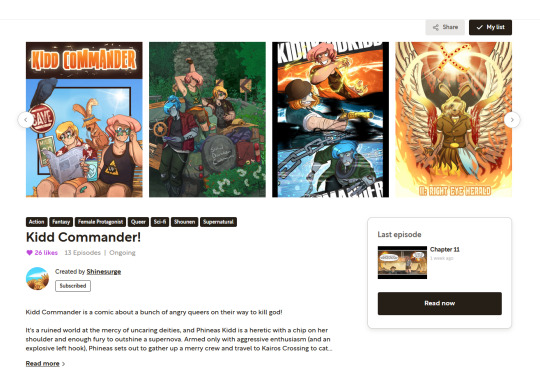
You don’t get a static banner and one icon, you get a whole carousel banner with as many images as you want front and center as soon as you get to the project page. You get seven (custom!) genre tags, as opposed to Webtoon’s single tag you have to pick from their list, and plenty of room to talk about your work. The episodes are even laid out better, you get a MUCH bigger preview space to work with and they’re nice and big on the bottom half of the page:
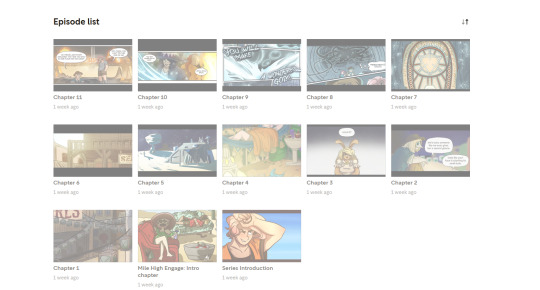
you know, like they’re actually presenting ART lmfao.
That’s already an ENORMOUS improvement, but here’s my favorite thing.
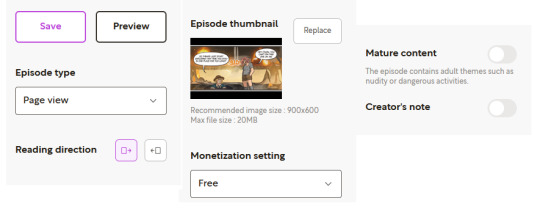
o hm that’s a lot of super cushy settings I have for every individual episode, but what’s that, Episode Type?
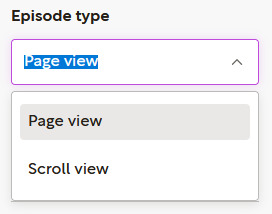
LIKE.
listen, i know this is probably a bit specialized if you’re not a comic maker yourself, but this is a HUGE DEAL. You can post vertically OR page by page! You can even post pages two at a time for double page spreads, or so they read like a physical comic book! AND their specs are really open, as long as the file meets the size requirement you can make it whatever shape you want. You don’t have to reformat all your shit to post here!! I posted the entire first volume of KC STRAIGHT FROM THE PRINT FILES in like half an hour!!! The episodes can also be any amount of pages, you can post a single page or an entire chapter all in one go!
So that’s just the project page for the comic, let’s see what happens when I click on my username there.
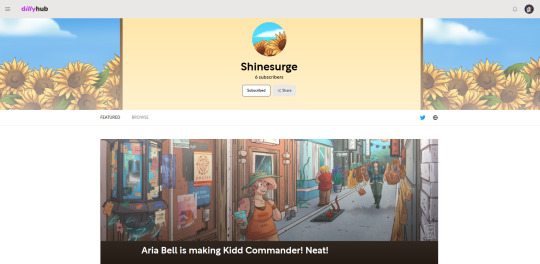

Each author gets their own unique page (which you can tack a vanity url to!) to present themselves however they want! You always have the banner at the top, but beyond that you have a ton of options. Among other incredibly useful tools that really should just be bare fucking minimum at this point, like the ability to preview your page on different devices, you start customizing your blank page with this set of widgets,

and from THERE you can customize them MORE, you can promote your patreon or your kickstarter or whatever! Having this creator space ALSO means that if you run several comics, or if you want to promote your comic AND your illustrations, you can just separate them into individual projects! Each with their own page! This is also really nice as a reader because you can subscribe to a creator but you can also just subscribe to specific projects, if you don’t want to get ALL of their stuff in your inbox. It’s so good y’all hh.
Once again, all of this functionality is just THERE as soon as you make your account. You don’t need to be “partnered” or whatever the fuck, you don’t need to meet a certain follower threshold to unlock the ability to operate normally. You get your own creator space to present yourself how you prefer, you get pages for all your projects, you can even set up monetization options (and change them for individual pages IN a project) right from the start.
ok ok let’s compare this to my webtoon page

oh that’s right webtoon just puts your greyed out name at the bottom of each comic and that’s it because human beings don’t make this stuff, my bad lol anyway
Other fun shit that Dillyhub does that makes me feel like they’re people who have actually consumed or made comics on the internet at some point in their lives:
-When you log into the “studio” space, you’re in your creator account. When you log OUT of the studio space, it’s like you swap to a “reader” account, where you can access your pull list and comment on things with a different name and profile icon. Again, maybe only cool if you’re a creator, but if you ARE then you know exactly why this is incredibly useful lmao
-You can set up “hidden” projects, so if you only want certain things to be accessible by certain people or to not show up in searches that’s an option! You have SO much control here it’s great.
-The comment section has moderation options GODDD. You also have a real comment space, you know, so it actually encourages building a community (and a rapport with your community, if you like), and you also can just turn comments off entirely if you want! I haven’t used it much yet, obviously, but it’s been made very clear in the discord that artists want better control over their comment sections and the devs have it on their priority list.
-Absolutely every step of customization gives you a preview before it’s live, so you can easily see what these images you’re posting in different places are going to look like before you beam them to your followers’ inboxes. This includes individual episodes!
-This was sort of in one of the screenshots but it’s important so I’m saying it here too: the option to mark individual episodes as mature or with content warnings, rather than having to mark an entire comic as Mature Spooky Scary Content because of one or two pages getting a bit hairy.
This site is only in alpha right now, and it’s invite-only until they get to beta (for creators; anyone can make a reader account! but they haven’t set up a way to browse comics without direct links yet so) but honest to god it’s already blowing every other site I’ve used clean out of the water. And the staff has been really kind and responsive to us proposing fixes or changes! I will always defend individual websites as being the best option for an indie comic, but everybody’s gotta start somewhere and we NEED something that isn’t Tumblr or Webtoon to fill this role; this site feels a lot more like a symbiotic relationship than any of the other staples available for new creators right now. If you’re a comic reader and you want to see your favorite comics on Dillyhub I’d suggest keeping an eye on this site and once it’s live start poking them to look into it, and if you’re a creator follow their social media and hop in when they open up for anybody to join. I would LOVE to see this site take off as a viable option for hosting and reading comics.
Thanks for reading all this! I haven’t quite finished setting up yet, but if you want to poke around a project/creator page for yourself mine is here have at it. As things progress I’m sure I’ll have more to say, but since I’m usually so aggressively negative about places like this I just wanted to give some credit where it was due. fucking finally.
37 notes
·
View notes
Text
Indie Author All the Way!

The publishing of Midnight Magic is coming to a close. I am waiting on Amazon to review part 11. This miniseries has twelve parts. The end is near. Part 12 will release next weekend. So that means that the full volume will come out in two weeks. If you have been waiting until all parts were published or you wanted only to read it as a novel, the wait is nearly over. If you pick up any part of the saga to read, let me know what you think. I'd love to hear from you.
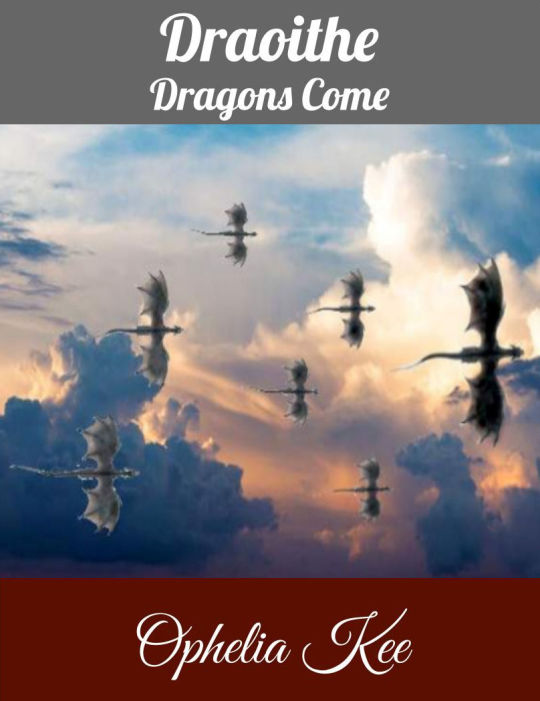
Draoithe: Dragons Come volume four has finally launched the 2nd edition as a 6x9 paperback. For those who don't know, I am pure indie and do all of my writing, publishing, and marketing on my own. When I first dove into the deep end of self-publishing, I had no idea what I was doing, but I could do it. I did it all wrong and made a ton of mistakes. When I could not figure out how to publish the books as 6x9 standard paperback book size, I decided to simply publish them as 8.5 x11. It was fine like that. I was learning. (They are kind of cool that way.) Only being a non-standard size meant that they were ineligible for expanded distribution and the wrong size for the book shelf. So I decided something needed to give and I had to break down and publish the stories as a second edition in the size they should have been. So as I go through the early stories and let Grammarly aid my editing for a cleaner story, I am also reformatting to release the stories in the proper book size. Volumes 1-4 and the Prequel are now complete. Just a few more to go. LOL. #don'tfearmistakes
Just the Facts
LINKEDIN.COM SELF PUBLISHING vs Publishing House - Look At The Numbers. This post is a follow up to a recent discussion I was involved in. IT IS I read this article on Linked-in the other day explaining the breakdown in earnings between traditionally published and indie published authors. Needless to say, indie authors earn way less than traditionally published authors. That's okay. Because it is offset by the fact that there is no need to suffer through query letters and rejections. As an indie author, I can publish as often as I like, as many titles as I want and best of all readers can simply read to their heart's content. There is no waiting until the publishing house is ready, or giving up any of my rights as the author to sell or promote my work however and whenever I see fit. So what if I don't get a big payout up front? I'm happy with waiting for my royalties. Advertising is entirely up to me and I don't have the added stress of needing to meet artificial deadlines or the potential hassle of losing the contract due to low sales or something else outside my control. It might not be the way to go for every writer, but so far, my authorwalk is still indie all the way. (Also I secretly enjoy publishing and the creative side of marketing even if I am not good at it and have limited marketing funds. LOL)
Mark the Calendar!
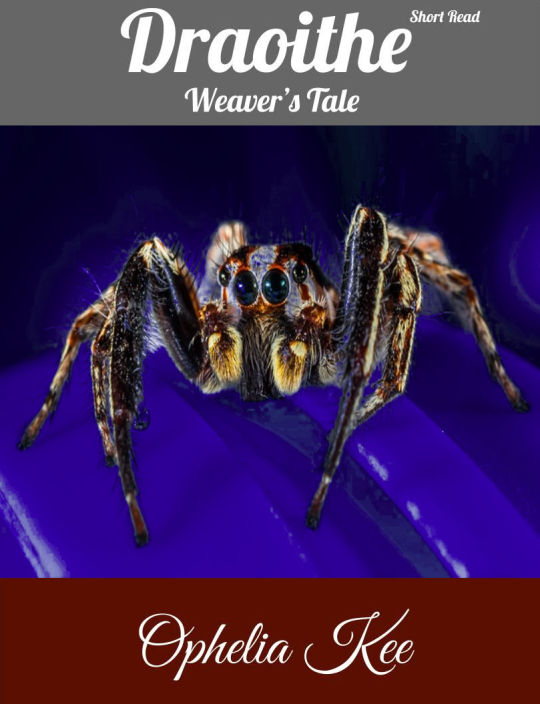
Weaver’s Tale Part 1 will be FREE October 15-19. Just in time for Halloween. Grab the first part of the 4 part miniseries, meet Araack Kniid, the warlock spider shifter, and Calvin Birchard, the wizard. Both men spend years learning and improving themselves in their desire to be worthy of a mate. Old lies and impossible fantasies must be overcome in order for them to finally have a life worth living. Step into the dream and meet the rulers of the Longest Purple. Author's note on Weaver's Tale: My mother said, "Just don't go adding spiders to the saga." Vampires and angels were okay, but spider shifters were just too creepy. Sadly, the scenes began to play out in my head immediately. I knew Araack Kniid and Calvin Birchard right away and sat down to write exactly what she said I should not. No disrespect, Mom. I had to write this novella length miniseries because until I write a scene that I see, I can't get it out of my head. Almost Noir, but not quite. This one is a fast paced read set in the Netherworld. Adult content and themes. Happy Halloween!
Updates!

Working on the video book for The Thread! Still no fixed release date, but I am super excited! The project is rolling along. I am hoping to have it up by Christmas. If you are not subscribe to OpheliaKee on YouTube, you might want to take a moment and hop over and set yourself up to get notified when the video books come out. Book trailers and ads are posted there already. Check it out and please give feedback. I love to hear from readers. Merch is still a big fat no go. GRRR.... I am not giving up, but the tech does sometimes seriously stress me out. Patience. My authorwalk has taken me in strange directions many times before. That's okay. I will prevail or die trying. Lol. So overdramatic. Debating a wikipedia page next too. So long as we are being extra...
Enough of the silly business. I gotta get back to writing, editing, publishing, and marketing. If you have questions or comments hit me up. As always if you read, please be kind and leave your review. Indie authors especially will love you for it. Be Careful! Happy reading, Ophelia Kee
1 note
·
View note
Text
1. Welcome to My Alternate History of the USFL
“If GOD had wanted football in the Spring, he wouldn’t have created baseball.”
---Donald Trump, owner of the New Jersey Generals, a team in the United States Football League, a spring football league.
Trump made that statement to the media as part of an active campaign to discredit the idea of spring-time professional football.
Trump’s fellow USFL owners were content with the spring when Trump finally got around to buying into the league prior to its second season, so Trump wanted to create momentum for a move to the fall. So he went to the media.
As a teenager I remember thinking, “Doesn’t he realize that he is hurting the businesses of all of his fellow owners?”
The thoughts of children....
About a year ago I decided to write an alternate history of the United States Football League after reading a post by Allen Bertsche (a.k.a. “Wide Right”) who wrote an alternative history of the USFL, beginning after the 1984 season that I thought was quite inspiring.
I have long thought the USFL had a shot if Donald Trump and Eddie Einhorn had not taken the league off a cliff.
I have read a ton of articles, websites, and books about the USFL.
After reading Mr. Bertsche’s writing I became even more convinced that the league walked away from a viable product specifically due to that vote.
Survival may have been surprisingly possible
Now some of Allen’s premises I found to be very, very unlikely, but as I read, I was sucked into the fact that his contentions overall didn’t seem all that unreasonable.
I wasn’t prepared for that.
I couldn’t escape the underlying premise that had some minor actions changed for the USFL — even after what I had always considered “the point of no return” — the 1984 season — the league could have been saved.
Some of his ideas about which players might head to the USFL after 1984 are incredibly insightful and, if things had unfolded in a different manner, probably would have happened. So from time to time in my chronology, you’ll see some parallels to his timeline as I steal / plagiarize certain things from his chronology. (Imitation is the sincerest form of flattery, Mr. Bertsche.)
I began to write and soon my normal blog, The Sports Minority Report, was filled to the brim with posts about this alternate timeline for the USFL.
Eventually, I couldn’t stand it anymore and decided to move it to the dedicated blog you are reading now.
........
This may be all you want to read in this first post. Things get moving and shaking in post #2.
To get there, you can skip to the end of this article. On every page there is a link to the next piece of this alternate history.
The rest of this post is an FAQ.
Q: You had this formatted differently in the old blog...Why reformat everything?
A: I have tried to cut the articles into more bite sized pieces here with each post covering a specific subject.
My goal was to paint a three dimensional picture of what could have been if people with interests contrary to running Spring football teams didn’t convince the struggling USFL owners to jump off a cliff, taking down several solid franchises.
One of my goals was to show that this wasn’t just a non-viable idea. This was a typical business with struggles, that a pair of corporate raiders skunked.
But in fleshing that out, I ended up with posts that were just too long.
I have tried to make this more reader friendly by “chunking” it more by main ideas.
Doing so also makes it easier for me to write future seasons as the membership swells.
Q: “Who cares about the USFL? It was bush league football.”
A: I do for one, and No... it really wasn’t.
A lot of USFL superstars went to the NFL after the league ended and those superstars dominated there too on their way to Hall of Fame careers.
I think the USFL was on a better than parallel development path to the one the American Football League took. And the Jets beat the NFL’s champ in Superbowl III!
The USFL had a LOT more star talent, and a lot more talent overall than the AFL, much earlier in their existence. If you look around you will find that no one disputes that point..
And a lot of that was due to George Allen. Allen organized tryouts all over the nation. He was a bit gluttonous (signing ----no joke --- about 350 players who flashed in his workout to contracts to his initial Chicago Blitz team, lol...) but a ton of those players made it on to USFL rosters in year one.
The league started in year one with a talent level leagues like the XFL and UFL couldn’t touch.
I read a news article written by Hall of Fame Pittsburgh WR turned TV analyst Lynn Swann published after the USFL’s initial season. Swann had just recently retired from the NFL after the 1982 season.
After watching the USFL’s first season, the difference he saw in terms of level of play with the USFL was that the new league had little depth at that point compared to NFL rosters and they played with more simplistic coverage schemes to cover a lack of secondary talent and depth.
That said, Swann said that several USFL teams’ starting lineups could compete with NFL teams.
Given Swann’s comments , I feel safe in saying good USFL teams would not have dominated in the NFL, but it is fairly likely at least the top 4 teams in year one (Chicago, Detroit, Philadelphia, and Boston) could have beaten a fair number of NFL teams.
They might have been 6-9 win teams in the NFL...even with their lack of depth.
And the USFL’s talent level improved every year.
A lot of USFL players have made the comment that in year one maybe a third of team’s starting lineup were legitimate pro players. By year two, it might be 2/3 of their starting roster. By year 3 the entire starting units were legitimate pros.
(I think you can look at this as the natural payoff to having a league worth of players spending two paid offseasons training and improving their games under the supervision of quality coaches. Everyone with talent gets better with practice.)
Now the NFL HAD more talent, but you need to wrap your head around what that really means...
Something like 3% of Division I-A players will ever play for an NFL team.
With the USFL around, that number swelled to about 5%.
Do you really think a team comprised of players from the 4th and 5th percentile could not beat a team comprised from the top 3%? That is Oklahoma beating Texas or Michigan State beating Michigan or Auburn beating Alabama.
It happens all the time.
A lot of NFL coaches will tell you that the guys they cut in the final cut are just as talented as the backups they keep on the roster.
If you think about it, that makes a ton of sense. A coach might keep a guy on the roster who he trusts over a guy with more talent who he can’t trust.
The USFL starting lineups were made of those guys, with a sprinkle of high profile 1%ers.
One only has to look at the Superbowl III champion Jets to see what those kinds of guys can do against the “elite” if given 4-5 years of on the job football training.
At that 5% level, it is all about how you select and coach the talent.
A skilled solid NFL receiver might be a lower to mid tier star in the USFL ....if he landed with a coach who would maximize his talent.
Jim Kelly’s Run and Shoot offense dominated USFL secondaries by flooding the field with what the NFL at the time would have considered 3rd or 4th WRs. In the cookie cutter NFL world where everyone ran pro set offenses, those tiny receivers were a dime a dozen.
But then Jim Kelly explodes and one of his receivers (Ricky Sanders) goes to the NFL and dominates.
A sound NFL QB might be a star in the USFL because in the USFL’s early years the league’s secondary talent was a half step slower, turning NFL INTs into USFL completions.
That isn’t to say that the real superstars of the USFL --- Jim Kelly, Herschel Walker, Reggie White, etc. ---- the 1%ers wouldn’t also be superstars in the NFL.
It is important to get that. AND that the USFL was catching up to the NFL’s level of play faster than the AFL did.
It was legitimately a pro league. And that’s why people like myself still like thinking about it to this day.
Disclaimers
Alternate timelines involve a lot of wishful thinking and optimal decision making. It is easy to get lost in that.
I’ve tried to keep the sheer optimism to a minimum, and instead have focused on strategies that involved people might have employed if things had gone slightly differently.
But things go better for the USFL if they stay in the spring.
The money increases geometrically as new principles become involved and frankly the league gets better at being a league. It matches and then surpasses their spending rate, much as the AFL did.
The way to view this in writing it, is as if I have “tuned in” to an alternate timeline where the USFL made a couple optimal decisions early on, and now I am just reporting what happened.
I have made every effort to write this “organically”. I tried to make it realistic, with bumps and flubs along the way based on my perceptions of the owners, coaches, and front office personnel.
Principles on this chronology make pointed stances only to back off them a year later when the circumstances change.
That is how the USFL was.
Just like in the first two seasons where the LA Express, then the expansion Pittburgh Maulers franchise, both skipped on Dan Marino ---- opportunities are missed in my timeline when the principles involved would actively pass on a great option.
You’ll see years where the conditions financially are rough for USFL owners. You’ll see them really pass for the most part on name prospects, resigned to sign rookies who will take the league minimum or backups on other teams.
One of the reasons I keep writing entries is that I am absolutely taken with how many top college players the survival of this league could have employed.
And how few it hurts. With the exception of Brett Farve. (Poor, poor Brett Farve....But that season is very far up the list.)
Three areas with big mistakes
This blog is setup to trace this league into late 80′s and beyond. That created a lot of hugely time consuming issues.
I curse myself for adding annual breakdowns of notable players on each team’s rosters. I have players on multiple rosters here and there. I have to have those lists to keep the players straight, but it is a major pain to fix a misplaced or duplicate player over several seasons.
I also have some of these guys playing WAAAAY too long. Some of these guys were on their last legs when the league started and wouldn’t be backups or starters even in 1985. I don’t think those guys retiring dramatically change how I would think the teams would finish. Most teams maybe had 1 or 2 old difference makers and I caught those. George Allens team had many and I think I had that team basically getting old overnight.
What I am more talking about are the middling starters and notable backups that were old. I will fix that in time.
Stadium capacities are also an area where I may have mistakes here or there. I have made every effort to get the stadiums capacities right for the years, but human errors occur.
Also as the league survives their home stadiums would be updated or in certain situations, like San Antonio, replaced.
I have tried to show that.
Reallocation
Every time there is expansion, players are reallocated. As I was doing this I noticed that sometimes I reallocated players a couple times. At first I thought that was just lazy and bad writing. (and admittedly some of it may be...)
But I thought about reallocation in real leagues and you see the same thing occurring.
There are “types” of players who are just more likely to get reallocated in real life and in alternate timelines.
When you are building a team via an allocation draft, you generally want players from the following categories:
1) The one year, older, expensive guy. A name player past his prime your fans know and can cheer for. If the allocation requires teams to take on salary, this guy may have one expensive year remaining and he may be picked exclusively for that reason and not for how he played.
2) The cheap guy with minimal talent but a great attitude, work ethic, and techniques. The idea is that you are going to draft and sign talented players that will steal these guys’ jobs. You want as many of these guys as possible to create that kind of environment. You want to see your system being executed right, even if your players have marginal talent.
3) The cheap young guy with great raw talent that hasn’t been tapped either due to lack of playing time, a bad system fit, or poor coaching.
I have tried to apply that.
That is why I have a guy like WR Neil Bahlholm who tied for 9th in the league in receptions in year 1 with 63, getting reallocated a few times. Bahlholm averaged 11.2 yards on those catches. He was a BYU product at a time when BYU was cranking out a lot of very polished slow white receivers with great hands.
He hits me as a category 2 guy.
If you catch 63 passes in any league and aren’t on crack, teams will give you the benefit of the doubt.
Some transactions may or may not make sense at first glance
I have far too much pro football minutia in my head. It is booth a boon and a hindrance in writing this. It is a big factor in transactions and injury assessments.
Arizona Wrangler coach George Allen had a method. He ran a 4-3 defense he filled with veterans who didn’t make mistakes that he would stock with defensive linemen who could pass rush playing from multiple positions in order to protect his team from injuries.
I feel confident in saying if George Allen left the league and came back at some point he would build a team using that same model. Now did I chose the right kind of defensive linemen? I don’t know, but I have tried to use a logic path that might make sense for George Allen.
I have former Atlanta Falcons coach Leeman Bennett coaching a USFL team. At one point that team needs a RB. When Leeman Bennett was the head coach of the NFL’s Tampa Bay team, the Bucs brought in RB Vagas Ferguson. I had Vagas Ferguson backing up on another USFL team, so I assumed Ferguson was Bennett’s kind of back, so I had him move to Bennett’s team.
While some of the moves I list are not as well thought out as that, There are a lot of moves that have an unstated logic behind them.
I know that Brian Bosworth had a degenerative shoulder condition that pretty much destroyed his pro career. I write about Bosworth assuming you all know that and don’t think, “well, if he played in a lesser league he wouldn’t have incurred that problem.”
No, not the case. He was going down anyway. Regardless of the pro league he had about 2 years of painful tackles in him before he’d have to retire.
Now Syracuse NT Ted Gregory was a great college player who had a damaged knee when he was drafted by the NFL Broncos in the first round. The NFL has no patience for that. They have too much invested for a #1 pick to not show anything for a year and a half. Bring on the next guy. And no other NFL team is chomping at the bit for a damaged player who his team was embarrassed about drafting. His career was done.
In the USFL could he have rehabbed his knee and been at least a backup? I can’t say, but I can’t write it off as impossible. If he could play at some point, a USFL team would take him. So I have him kicking around on the roster of the USFL team that drafted him for a few years.
You may wonder why I assume some other players who had injuries that killed their NFL careers would not have ended up playing in the USFL.
It is because some injuries that ended careers prevented the players from ever playing like they could while other injuries just prevented the player from ever getting another contract. There is a big difference.
Draft day Busts and player movement between leagues
This is a hot button of mine. I get annoyed when people pronounce a player a bust.
To me, a bust is a player who doesn’t work at the game for whatever reason.
Oakland QB Demarcus Russell got fat and didn’t get back into shape. He was a bust. (I hear much of the problem with him was that he had a father figure Ray Ray Russell who died and it messed with his head. I am sorry for him having to go through that, but at the end of the day he didn’t do what he needed to succeed. Bust.)
Oakland QB Todd Marinovich had a drug problem. (Probably in no small part due to his parents divorce messing with his head. Again, sad, but still a bust.)
San Diego QB Ryan Leaf fucked up his wrist on his throwing arm big time in his NFL rookie season. Ryan Leaf may have been immature. He may have been a crap leader, but he wasn’t a bust. I saw him play a lot when he was trying a comeback with Dallas and you could see flashes of why teams loved him. If he doesn’t fuck up his wrist losing consistent accuracy, he is Jeff George. Still an asshole, but nobody is calling him a bust.
Oakland Raider Bob Buczkowski had a ridiculous 2 year run of injuries after the Raiders drafted him. Were some of those “out of shape” injuries? I don’t know, but I am not really comfortable hanging him with the bust tab either. He could have just been the victim of a horrible run of bad luck.
Denver first round pick QB Tommy Maddox came into the league early and predictably washed out. Then he matured, got a fresh start in the XFL where he could display his talent and then became a successful starting QB in Pittsburgh for a few years.
So was he a bust or wasn’t he? I would say he totally was a bust. ....But he got better.
Steve Young was was one of like 7 first round prospects signed by the LA Express that year for the media attention. He was a hard to contain player in the USFL, but his passing was a major disappointment vs. his collegiate excellence. Probably he was a bad fit in John Hadl’s offense. He went on to Tampa Bay and stunk up the joint. He worked hard but he was just bad. Then he lands in a system that accentuates his skills in San Francisco and becomes a Hall of Famer.
You could argue he was kind of a bust in the USFL and became an NFL hall of famer. How does that fit in your world view?
The problem with calling someone a bust is that you are lumping too many reasons together so you can have a quick one word description on why your pick didn’t work out.
The NFL has a real knack of drafting good players and slotting them in to systems where they don’t fit.
They draft a 6′7″ edge rusher to play inside linebacker.
They draft a 6′3″ 280 lb 3-4 DE who never had more than 7 sacks in a season in college, but they think he will be a terror as a 4-3 DE in the pros because he runs a 4.7 forty ---- even though he doesn’t show any pass rushing technique on film.
They draft killer collegiate 5′10″ safeties who run 4.4s and can tackle, play the ball in the air and pick off passes but can’t cover at all and NFL coaches want to make them all CBs.
A startup league like the USFL needed to hit on every player they gave big money to, so for the most part they made damned sure the player had a proven history of executing what they needed him to do. If they don’t think he will work out, they pick someone else.
They don’t have the luxury of an unlimited budget.
The NFL generally has a pretty hard divide between coaching and personnel. Coaches get players they can’t stand all they time. And they bury them thinking, “I’ll get a better replacement next year.”
In the USFL the staffs were smaller and they had a territorial player acquisition system so they didn’t have to scout the whole country. The coaches were much more involved and their coaching regimes had much shorter leashes, so you had a lot less of that.
It is an entirely different mindset.
All of this adds up to the fact that the USFL was well suited to “rehab” “NFL busts” and I would argue to successfully develop the college talent they signed..
Why would USFL teams sign NFL players?
In the early days of the USFL, the league would sign former NFL players to fairly big deals. They never seemed to get as much out of that payout as when they signed collegiate players.
And it was part of why their spending went out of control.
In writing this, I tried to put myself in the shoes of each USFL GM. There are years where they just don’t have any money and they league signs almost no NFL rejects. Then there are expansion years where expansion teams suck up excess talent and NFL players get signed.
I have tried to list it when it “makes sense” for a team to do it. For example when former TCU star RB Kenneth Davis became a free agent, Buffalo offered him the most money among NFL teams. I am sure he didn’t want to play in Buffalo, but as I was looking through USFL teams, there was no team at the time that it made sense for them to pursue Davis, even though Davis totally could have been at least an 800 yard rusher in the USFL.
I have tried to honor “supply and demand” in that way.
Defections in year 2
In our world, a number of notable names would walk away from the USFL in year 2 as the owners moved towards playing in the fall.
New Orleans offensive Coordinator Jim Fassel, who had coached in the WFL, bolted for the University of Utah. Players like Michigan RB Ken Lacy, Arizona CB Frank Minnefield, and others took off for the NFL.
This timeline is one where the decision not to move stops a lot of that movement dead in its tracks.
Retirements, draft nightmares, and deaths
People die. I am saddened as I write this that so many of the people I write about who made the USFL great (or might have down the road), are in jail or dead, often tragically.
I can’t help but wonder if they had had a consistent career the lasted for 4-15 years, helping them mature through their wild youth and putting a little money in their pockets if their lives would have taken a different path.
I can’t help but wonder if X player who flamed out in the NFL because he was drafted by a coach with an ill fitting scheme, or by a GM over the objections of his coach, or landed on a team with a bad position coach might have had an amazing life after playing in the USFL.
But that was taken from them and US, the fans.
And frankly, at times in my writing I have probably ignorantly listed people who may have died by that point.
There were probably backups who I mention as hanging around for future years who may have died in car accidents or other ways and their stories simply aren’t recorded on the sources I used. To them and their families, I apologize.
I hope people get that this is my love letter to those players, the people who made the USFL. It is me screaming out to the world that what they built was fantastic and could easily have lasted.
Re-Writes
I’ve re-written this a few times, consider this version 3.0.
If, from a logical standpoint, I’ve totally missed the mark at certain points in your opinion, please let me know and I’ll incorporate it into version 4.0, when I write that at some point down the road.
The role of a USFL Commissioner
Chet Simmons, the league’s first commissioner was concerned with building consensus. He was seen as a weak commissioner by the owners. They would eventually make that perception reality by creating committees that took away Simmons’ various powers.
Harry Usher, the league’s second commissioner, was hired specifically because Simmons was seen as a weak leader. The expectations were Usher would lead.
I have Harry Usher turning to Peter Hadhazy in an early incident in the Usher tenure, that working, and Usher going back to the well time after time. (I credit Hadhazy with seeing my own view that a bigger league is better/ more leikely to survive, but I have no idea if he thought that way. The league was pretty much imploding in our timeline when Usher took over, due to the vote to play in the fall. He plays a much larger role in this alternate timeline where it wasn’t .)
So at a point you’ll see decisions coming “top down” more than they were in our timeline.
High concept struggles
What Key Moment?
The USFL had several 'key moments’ that could have dramatically changed the direction of the league. An early one was the decision by David Dixon not to start a franchise himself. If Dixon had “skin” in the league, his sway over the other owners would have been much more pronounced and they likely would not have gotten as deeply into financial trouble as they did in the first season.
That in turn might have kept several financially conservative owners in the league following that first season.
But the decision most USFL fans look at as the point of no return was the 1984 vote to start playing in the fall beginning in the 1986 season.
Championed by New Jersey Generals owner Donald Trump and Chicago “franchise” “owner” Eddie Einhorn, that vote is the moment where several former USFL stars say they knew the league was dead.
That is the moment that my 13 year old heart broke because I knew the league was a dead man walking.
Over the years I have found that most USFL players appear to blame Trump for the league’s demise and over the years some high profile owners like Houston’s Jerry Argovitz have come to publicly concede that point.
youtube
A sadder, wiser Ted Diethrich, second owner of the Arizona Wranglers, would say many years later, “I think it [agreeing with Trump and Einhorn to move to a fall schedule in 1986] was a big mistake. When that decision was made, the course for this was charted....and it was going to be a wreck.”
Both Diethrich and Argovitz are named in books on the subject as having voted to play the 1986 season in the fall.
The league would never play that 1986 fall season.
Shortly before the season was to start, a lawsuit by a former player against the Tampa Bay Bandits for back pay would cause the Tampa Bay Bandits’ equipment to be seized. Down one team, the league would be inclined to press on, but they would turn to their surviving leader Donald Trump and Trump would advise them he changed his mind. Again.
He would not field his all-star merged New Jersey team with the league’s two superstars, RB Herschel Walker and QB Jim Kelly.
With no team in New Jersey, there was no hope for TV money. Trump had pulled the plug on the league.
The rest of the owners quit...
Why focus on the 1984 vote?
That 1984 vote is the key moment I address in this blog.
The 1984 vote boils down to the league deciding A) if they wanted to continue to run things like struggling businesses shy of their break even point or B) just treat the entire endeavor like a game of poker with the NFL, pushing in all their chips?
The USFL was not doomed to fail. Not everyone was broke.
What is lost on most people is that only about 1/3 of the league was financially distressed. These owners were looking for a magic bullet solution to fix their issues. They were susceptible to Trump and Eddie Einhorn’s pro-fall bullshit. (And in a lot of cases it was described as intentionally fabricated bullshit.)
These struggling owners outvoted the owners with the most financially solid positions, forcing the league out of several well performing markets, creating a “lame duck” final spring season when the fans stopped paying attention, and dramatically weakening the league.
In the lame duck season, the league would see attendance totally collapse to franchise failure levels in all of their teams in the western half the US as westerners wrote off the league as dead.
This blog answers the question, “What if the owners who had the USFL’s prospering teams won that vote?”
The over extended league owners chose ‘B’. This blog is about what would have happened if they had chosen ‘A’.
The USFL was not a harmonious group activity
Every owner had their own agenda that they put ahead of the best interest of the league. It is crazy, but yeah, they did.
I’ve tried to retain that too, even if I had the pro-spring teams “win” the key “play in the fall” vote.
The USFL owners frankly flocked to Alphas who generated money. This made Einhorn a big player in our reality and is something that plays a big role in this alternate history.
Bigger is better
Conceptually the biggest stretches I’ve taken are assuming that the league would generally support a “bigger (more teams) is better” philosophy in terms of survival if they were choosing good TV Markets.
This is definitely contrary to most people’s thinking. The 1970′s World Football League would have had a much better chance at survival if they hadn’t started each of their seasons with 12 teams. (They had a lot of problems.)
But the USFL was a different beast. Their plan eliminated most of the mistakes that sunk the WFL. They had the potential of TV paying them at quite a good rate for stringing together big media markets.
I contend for the USFL business model, more big market teams was better. It created more TV attraction. It created protection if a team failed.
I think that just makes sense, but it is at best a “neutral position” in terms of the PERSONAL investments of each team owner. (ie. More mouths to feed means slightly less revenue, potentially even with expansion fees, and can put the league at risk if non-viable locations are chosen or if teams are very poorly run, but on the other hand expansion does create more wins for established teams and wins can help a team survive.)
Player retirements, injuries, and lost opportunities
In real terms, most players retire when no one will pay them to play anymore. Some retire due to injuries. That is a real problem in writing this.
Marcus Dupree was probably the second most talented RB in the USFL behind Herschel Walker and the 3rd most talented back in football at the time behind Eric Dickerson. (I am only talking talent here, Kelvin Bryant fans....)
His team moved to Portland where the the turf was horrifically unsafe. Dupree blew out a knee and his USFL career was over. If the vote to move to the fall fails, Dupree’s team stays in New Orleans and he never blows out his knee on that Portland turf.
Would he blow out his knee somewhere else? Can I predict that? Should I? I had to think, “No,the other turfs were good, so he probably would not.” So in that, I am being very optimistic about the health of players in the USFL.
Ken Talton ran for a 1000 yards for Birmingham in year 1. He had talent, was trusted, and given plenty of opportunities. That happens for talented unknown pros when the league is growing.
Then he was replaced by Joe Cribbs as Birtmingham’s primary rushing threat in year 2 and only ran for like 150 yards. He was 28. He didn’t play in year 3. Did he piss someone off in Birmingham? RBs fall off around that age... Did it happen to him? Or did the contraction of the league cause him and several other solid players to be forced into retirement?
I think the later is more likely.
Ken Talton may have played and carried the ball for several more years if the league survived and the number of teams was growing instead of shrinking.
Eventually teams take a hard look at a player’s age. A lot of older players can still play at a high level for 1-3 more years at that point but teams get scared of their age (and their salary demands) and go for younger players.
Other teams assume the players have less in the tank or they wouldn’t have been let go. Or they assume (sometimes correctly) that the player’s salary demands might be cost prohibitive.
What I am getting at is that a lot of players retire with “meat left on the bone” of their playing career. That is increased when the league is contracting and jobs are going away like the USFL in year 3.
Also, it is plainly obvious that the NFL blackballed most USFL players. There were simply too many good starters in the USFL who never got a legit opportunity when the league went down.
The level of play in the USFL was legitimately lower than in the NFL overall, but really what happened to a lot of these players --- like Oakland star WR Fred Banks --- is they went from a team that trusted them and used them correctly to a team where they had no trust equity, in a league that really kind of wanted USFL players to fail overall.
If the USFL survives, If USFL guys stay with their USFL teams, they likely have careers that mirror NFL starters in terms of consistency of play and length of careers.
So you will see that in my work.
It doesn’t mean that they would be stars in the NFL if they were stars in the USFL, but it is still pretty darned prestigious company.
But I say this only to explain the logic behind why, in this blog, you will see players playing longer than they did and often at higher levels than you might expect if your only knowledge of them is looking at their NFL stats.
With that said, lets get into this...
Click here to continue to the next post
0 notes